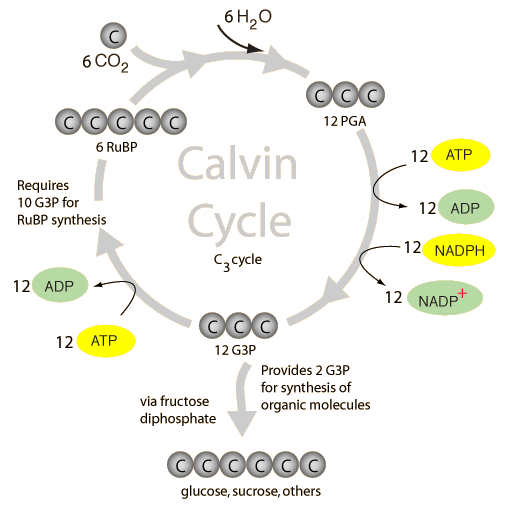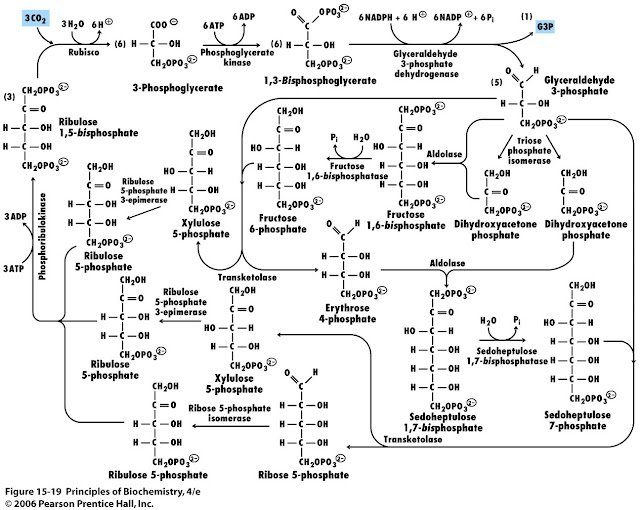Daily Newsletter
October 11, 2012 Calvin Cycle
Happy 10/11/12
The energy created during the Light Dependent Reactions will be used in the Calvin Cycle to reduce carbon compounds, with the end result being the production of glucose. In your studies of biology, you may have seen the following reactions:
Cellular Respiration
C6H12O6 (s) + 6 O2 (g) → 6 CO2 (g) + 6 H2O (l) + heat
Photosynthesis
light + 6CO2 + 12H20 --> C6H12O6 + 6O2 + 6H20
They look simple, but as we have discussed with cellular respiration, it takes many steps to get to the final product. Likewise, with photosynthesis, we are not going to complete this general reaction in one step. One common misconception is that Cellular Respiration is the reverse of Photosynthesis. On the surface they may appear to be reversals, but you're not going to see cellular respiration solely in reverse (there are times that you will see some reactions from glycolysis).
As we learned yesterday, we can break the Calvin Cycle into three stages: Carbon Fixation, Reduction and Regeneration.

The diagram to the right gives a little more detail on these stages. Yesterday, we discussed the carboxylation of ribulose 1,5-bisphosphate (Carbon Fixation). The product of that reaction, Phosphoglycerate (PGA) is the the substrate for the reduction stage of the Calvin cycle. As the diagram shows, this is where ATP and NADPH is used. The reduction stage ends with the production of Glyceraldehyde 3-P (G3P). Two out of every 12 molecules of G3P created will be used to make a hexose (e.g. glucose). The other 10 molecules of G3P will be used to regenerate the 5 carbon RuBP. The conversion of G3P to RuBP is the regeneration step.
Note that the calvin cycle must run multiple times to get a single glucose molecule. 6 RuBP must be carboxylated. 12 PGA must be reduced. 10 G3P must be regenerated. It is not as simple as glycolysis and citric acid.
The following diagram gives you some of the complexity of the Calvin cycle. You are not expected to memorize this, but with your growing knowledge of reactions, you may find you can follow it.

If you notice, the set of reactions at the top of the image show the Carbon Fixation and Reduction steps. Everything else deals with regeneration. (think about it: how do you change 10 3-carbon compounds into 6 5-carbon compounds?). Recall that with glycolysis and citric acid, the intermediates were used for other reactions. The same thing is happening here. These intermediates of the regeneration stage can be used for other chemical processes.
Daily Challenge
In your own words, describe the Calvin (Calvin-Benson) Cycle. Explain how it works, and where the energy from the Light Dependent reactions will be needed.Link to Forum

No comments:
Post a Comment